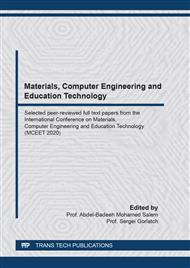[1]
Adebiyi, A.A.; Adewumi, A.O.; Ayo, C.K., Comparison of ARIMA and artificial neural networks models for stock price prediction. J. Appl. Math., Article ID 614342 (2014).
DOI: 10.1155/2014/614342
Google Scholar
[2]
Alsharif, M.H.; Younes, M.K.; Kim, J., Time series ARIMA model for prediction of daily and monthly average global solar radiation: The case study of Seoul, South Korea. Symmetry, 11(2019) 240-258.
DOI: 10.3390/sym11020240
Google Scholar
[3]
Bianco, V.; Manca*, O.; Nardini, S., Electricity consumption forecasting in Italy using linear regression models, Energy. 34 (2009) 1413–1421.
DOI: 10.1016/j.energy.2009.06.034
Google Scholar
[4]
Box, G.E.P.; Jenkins, G.M., Time Series Analysis: Forecasting and Control. Revised Edition, Holden Day, San Francisco. (1976).
Google Scholar
[5]
Covid-19.in, (2020). https://www.mygov.in/covid-19/?cbps=1.
Google Scholar
[6]
Covid-19 in India, (2020). https://www.kaggle.com/sudalairajkumar/covid19-in-india.
Google Scholar
[7]
Covid-19 India, (2020). https://www.covid19india.org/.
Google Scholar
[8]
Dehesh, T.; Mardani-Fard, H.A.; Dehesh, P., Forecasting of COVID-19 Confirmed Cases in Different Countries with ARIMA Models. MedRxiv. (2019) 1-12.
DOI: 10.1101/2020.03.13.20035345
Google Scholar
[9]
Hassan, S.; Sheikh, F.N.; Jamal, S.; Ezeh, J.K.; Akhtar, A., Coronavirus (COVID-19): A review of clinical features, diagnosis, and treatment. Cureus. 12(2020) 1-7.
DOI: 10.7759/cureus.7355
Google Scholar
[10]
Jakhar, M.; Ahluwalia, P.K.; Kumar, A. COVID-19 Epidemic Forecast in Different States of India using SIR Model. medRXiv The Preprint server for health sciences. (2020) 1-19.
DOI: 10.1101/2020.05.14.20101725
Google Scholar
[11]
Khashei, M.; Bijari, M.; Ardali, G.A.R., Improvement of auto-regressive integrated moving average models using fuzzy logic and artificial neural networks (ANNs). Neurocomputing. 72(2009) 956-967.
DOI: 10.1016/j.neucom.2008.04.017
Google Scholar
[12]
Liu, Y.; Gayle, A.A.; Wilder-Smith, A.; Rocklöv, J., The reproductive number of COVID-19 is higher compared to SARS coronavirus. J. Travel Med., 27(2020) 1-4.
DOI: 10.1093/jtm/taaa021
Google Scholar
[13]
Lockdown, (2020), https://en.wikipedia.org/wiki/Lockdown.
Google Scholar
[14]
Maheshwari, H.; Yadav, D.; Chandra, U.; Rai, D.S., Forecasting epidemic spread of COVID-19 in India using arima model and effectiveness of lockdown. Advances in Mathematics: Scientific Journal, 9(6) (2020) 3417–3430.
DOI: 10.37418/amsj.9.6.22
Google Scholar
[15]
Meyler, A.; Kenny, G.; Quinn, T., Forecasting Irish Inflation Using ARIMA Models. Technical Paper 3/RT/1998, Central Bank of Ireland Research Department. (1998).
Google Scholar
[16]
Ranjan, R., Predictions Forcovid-19 Outbreak in India Using Epidemiological Models. medRXiv The Preprint server for health sciences. (2020) 1-11.
Google Scholar
[17]
Shereen, M.A.; Khan, S.; Kazmi, A.; Bashir, N.; Siddique, R., COVID-19 infection: origin, transmission, and characteristics of human coronaviruses. J. Adv. Res. 24(2020) 91-98.
DOI: 10.1016/j.jare.2020.03.005
Google Scholar
[18]
Sohrabi, C.; Alsafi, Z.; O'Neill, N.; Khan, M.; Kerwan, A.; Al-Jabir, A.; Iosifidis, C.; Agha, R., World Health Organization declares global emergency: A review of the 2019 novel coronavirus (COVID-19). Int. J. Surg. 76 (2020).
DOI: 10.1016/j.ijsu.2020.02.034
Google Scholar
[19]
Tomar, A.; Gupta, N., Prediction for the spread of COVID-19 in India and effectiveness of preventive measures. Science of the Total Environment, 728(2020) 13876.
DOI: 10.1016/j.scitotenv.2020.138762
Google Scholar
[20]
Tran, T.T.; Pham, L.T.; Ngo, Q.X., Forecasting epidemic spread of SARS-CoV-2 using ARIMA model (Case study: Iran). Global J. Environ. Sci. Manage. 6(2020).
Google Scholar
[21]
WHO, (2020a). World Health Organization website. https://www.who.int/emergencies/ diseases/novel-coronavirus-2019/technical-guidance/naming-the-coronavirus-disease-(covid-2019)-and-the-virus-that-causes-it.
Google Scholar
[22]
WHO, (2020b). World Health Organization website. https://www.who.int/health-topics/coronavirus.
Google Scholar
[23]
WHO, (2020c). Coronavirus disease 2019 (COVID-19) situation Report–95. https://www.who.int/docs/default-source/coronaviruse/situation-reports/20200424-sitrep-95-covid-19.pdf?sfvrsn=e8065831_4.
Google Scholar
[24]
Worldometers, (2020). Countries where COVID-19 has spread. https://www.worldometers.info/coronavirus/countries-where-coronavirus-has-spread/.
Google Scholar
[25]
Yadav, D.; Maheshwari, H.; Chandra, U., (2020). Outbreak prediction of covid-19 in most susceptible countries, Global J. Environ. Sci. Manage. 6(2020).
Google Scholar
[26]
Yadav, D.; Maheshwari, H.; Chandra, U., Sharma, A., COVID-19 Analysis by Using Machine and Deep Learning, Internet of Medical Things for Smart Healthcare, 2020, pp.31-63.
DOI: 10.1007/978-981-15-8097-0_2
Google Scholar


